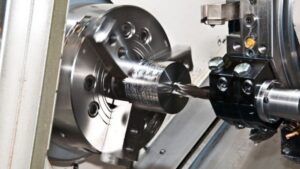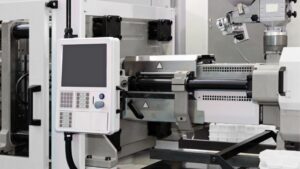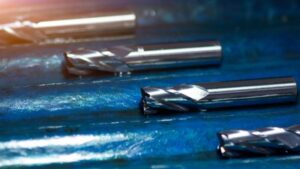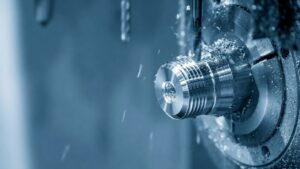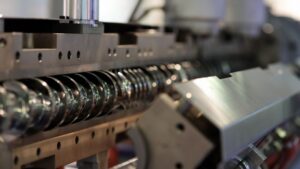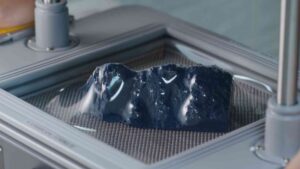Plastic injection molding is a widely used manufacturing process that is both cost-effective and versatile in producing complex plastic parts. It involves melting plastic granules and injecting them into a mold cavity, where they solidify and take the desired shape. A key aspect of this process is the design of the mold itself, which greatly impacts the quality, appearance, and functionality of the final product.
The fundamentals of plastic injection mold design incorporate a variety of components and features, such as gates, runners, and cooling systems, each playing a crucial role in achieving optimal results. Accurate mold design goes hand in hand with material selection and flow properties, ensuring efficient filling and solidification, as well as minimizing defects like warping and sink marks. Moreover, injection mold design caters to a multitude of industries, such as automotive, aerospace, medical, and consumer products, showcasing its immense potential.
Key Takeaways
- Plastic injection mold design is crucial for producing high-quality, complex plastic parts.
- Mold components and features, material selection, and flow properties impact the final product.
- Injection molding is widely used across multiple industries due to its versatility and cost-effectiveness.
Fundamentals of Plastic Injection Mold Design
Injection Molding Process
The injection molding process is a popular method for manufacturing plastic parts. To get started, you’ll need to obtain molten plastic material, usually in the form of pellets. These pellets are then heated until they become a molten state, which is then forced into the injection mold under high pressure. The molten plastic fills the mold cavity, taking the shape of the intended part. Once the plastic cools and solidifies, you’ll remove the final part from the mold, often with the help of ejector pins.
When designing the mold, consider factors like the flow of plastic, cooling rates, and shrinkage. By following some basic rules of injection molded part design, you’ll create parts that are easier to manufacture and assemble, typically resulting in stronger products.
Types of Injection Molding
There are several types of injection molding techniques, and knowing the most common ones can help you make informed decisions for your molding projects.
- Standard Injection Molding: The most common method, which involves the process we described above. This technique is best suited for parts with relatively simple geometries and materials.
- Gas-Assisted Injection Molding: This technique injects a polymer melt along with pressurized gas such as nitrogen. The added gas helps to create hollow sections within the part, reducing weight and material consumption, while maintaining structural integrity.
- Two-Shot Injection Molding: Also known as double-shot or over-molding, this technique involves molding two different plastic materials onto each other, creating a single part with multiple materials. This process can be useful for creating complex geometries and multi-colored parts.
- Insert Molding: This method involves placing an insert, such as a metal component, into the mold cavity before injecting plastic. Doing so allows the plastic materials to form around the insert, binding together in the finished part.
Remember, when choosing the best method for your design, consider factors like material compatibility, part geometry, and desired end-use properties. With these fundamentals in mind, you’ll be well on your way to creating successful plastic injection molds.
Mold Components and Features
In plastic injection mold design, understanding various mold components and their functions is essential to create high-quality parts. We’ll be discussing four key aspects of plastic injection mold design to help you better understand the process.
Core and Cavity
The core and cavity are two main components of the mold. Your part is formed in the cavity, whereas the core creates a reverse, solid shape within the cavity. The material flows around the core, taking the form of the desired part. Proper design of these two elements ensures accurate part geometry, minimizing defects and ensuring part quality.
Runner System
The runner system is responsible for guiding the molten material from the injection unit to the mold cavity. It usually consists of a sprue, a primary channel leading the material into the mold, and runners, secondary channels branching off from the sprue to direct the material into the cavity.
Runner systems can be either cold or hot, depending on the material’s properties and application.
Key elements of the runner system include:
- Sprue: The primary channel guiding the material into the mold.
- Runners: Secondary channels connecting the sprue to the gates.
Ejection System
An ejection system helps remove the molded part from the mold cavity after the material has cooled and solidified. It is crucial to design an efficient ejection system to avoid part damage, warping, or sticking.
Ejection systems typically consist of ejector pins, which apply force to specific areas on the part to ensure clean and even removal.
Key elements of the ejection system include:
- Ejector Pins: Pins that apply force to the part for easy removal.
Gates
Gates are small openings that control the flow of material into the mold cavity. They determine the filling pattern, pressure, and the way your part solidifies. The positioning of gates plays a crucial role in creating high-quality, defect-free parts. There are several types of gates, including edge gates and hot tip gates, which you should consider according to your requirements.
Various gate types include:
- Edge Gate: Attaches to the part’s edge, providing rapid filling, but may create a visible mark on the part.
- Hot Tip Gates: Designed for hot runner systems, they ensure precise material flow with minimal pressure loss, reducing visible marks on the part.
By understanding these critical components and features, you can better design your plastic injection molds, ensuring the production of high-quality, functional parts that meet your needs.
Design Considerations for Plastic Parts
Wall Thickness
Choosing the right wall thickness for your plastic part is crucial for maintaining structural integrity and preventing warping or defects. Here are a few guidelines:
- Keep the wall thickness as uniform as possible — this helps resin fill the mold evenly for minimal sink marks or shrinkage.
- It’s best to use a moderate wall thickness — too thin could result in short shots or breakage, while too thick can cause uneven cooling and longer cycle times.
Draft Angles
Draft angles are small slopes applied to the walls of your part design to make it easier to eject the part from the mold. They also ensure proper mold filling and smooth surface finishes. Keep in mind:
- Add a minimum draft angle (usually between 1 to 2 degrees) to all vertical walls in your design.
- Deeper features or textured surfaces may require additional draft angles to prevent part deformation during ejection.
Ribs and Bosses
Ribs and bosses are essential for reinforcing and connecting parts of your design without adding too much material or weight. To effectively use ribs and bosses, consider the following:
- Ribs should be around 60% of the nominal wall thickness for robust structural support.
- Maintain a consistent wall thickness between the ribs and the main wall.
- Ensure that bosses have sufficient surrounding material to minimize stress concentrations.
Undercuts and Side Actions
Undercuts and side actions refer to features that require additional tooling or mechanisms within the mold to form and release the part. When designing your plastic part, consider these aspects:
- Simplify your design to avoid undercuts whenever possible.
- Should undercuts be necessary, evaluate the feasibility of incorporating side actions or collapsible cores in your mold design.
- Account for increased tooling costs and longer lead times if side actions or complex mechanisms are required.
By following these guidelines for wall thickness, draft angles, ribs, bosses, and undercuts, your plastic injection mold design will be on its way to success. Remember to keep a balance between functionality, manufacturability, and aesthetic appeal. Good luck with your project!
Material Selection and Flow in Injection Molding
Types of Plastic Materials
When selecting materials for injection molding, you should consider various types of plastic materials. Some common materials include:
- ABS (Acrylonitrile Butadiene Styrene): A popular choice for its strength and impact resistance, ABS is easy to process and offers a good cosmetic surface finish.
- Polystyrene: A cost-effective option suitable for low-stress applications, it offers excellent dimensional stability and ease of processing.
- Nylon (Polyamide): Known for its high strength and good wear resistance, nylon is often used in mechanical and automotive components.
- Polyethylene: Available in high and low-density variants, polyethylene exhibits excellent chemical resistance and impact strength.
- Polycarbonate: Offers high transparency, impact resistance, and can withstand high temperatures, making it suitable for lenses and electrical components.
- Polypropylene (PP): A versatile material with high chemical resistance, PP is widely used in automotive, packaging, and consumer goods applications.
Consider your part’s function and requirements while choosing the plastic material. Be aware of each material’s strengths and limitations.
Resin and Material Properties
Once you have chosen the plastic material type, you’ll need to account for the resin and material properties for your design. Many factors impact the material’s performance, including:
- Fillers: The presence of reinforcements or fillers can enhance specific properties, such as strength, stiffness, or wear resistance.
- Colorants: Some resins include pigments or dyes that may affect the material’s properties, processing, or final finish.
- Additives: Chemical additives can optimize certain material characteristics like flame retardancy, UV resistance, or lubricity.
Viscosity and Material Flow
Understanding the viscosity and material flow is essential for successful injection molding. It helps in identifying appropriate gate locations, wall thickness, and radii for your design. Key factors include:
- Hopper: The hopper affects the feeding of the plastic materials into the injection molding machine. It is important to consider the size, shape, and flow of the resin pellets.
- Mold Cavity: Material flow is influenced by mold cavity design. It is crucial to maintain uniform wall thickness and avoid sharp corners or drastic thickness changes to ensure smooth material flow.
- Viscosity: Different materials exhibit varying degrees of viscosity at various temperatures. You will need to determine the optimal temperature and pressure settings for your chosen resin.
- Heat Transfer: Proper cooling and heating are essential to control material flow. Rapid cooling results in a more crystalline structure, while a slower cooling rate can produce a more amorphous part.
By taking these factors into account, you can optimize material selection and flow for your injection molding project. This will ultimately contribute to higher-quality parts with fewer defects and improved production efficiency.
Optimizing Injection Mold Design
Cost and Lead Time Reduction
To reduce cost and lead time, it’s important to focus on several aspects of your injection mold design. Minimizing material usage and optimizing runner systems can help reduce your overall cost. Selecting the most appropriate materials can also save you money in the long run, as it can improve part quality and reduce production issues.
- Choose materials with suitable performance characteristics for your desired application
- Optimize gating and runner systems to reduce material waste
- Incorporate features in the design that reduce stress and prevent warpage
- Utilize standardized mold components to decrease production time and costs
Minimizing Defects and Improving Quality
In order to produce high-quality parts with minimal defects, you should pay attention to the following aspects:
- Avoid sharp corners and geometric features that can cause stress concentrations
- Consider wall thickness to minimize shrinkage and sink marks
- Ensure adequate parting line design to reduce flash and mismatch
- Optimize gating systems to provide a uniform flow of material and prevent defects like short shots or weld lines
- Use simulation tools, such as Finite Element Method (FEM), to predict and address potential issues in the design stage
Maximizing Design Flexibility
Design flexibility is key when optimizing your injection mold design for various applications. To enhance design flexibility, consider these recommendations:
- Take advantage of additive manufacturing and other advanced technologies to create more complex geometries and structures
- Design parts with a focus on functionality and structural performance, rather than strictly adhering to traditional processing limitations
- Explore innovative molding processes, such as gas-assisted injection molding or micro-cellular foam injection, for unique part characteristics
- Keep in mind that the repeatability of your process is essential for consistency in part production, as well as maintaining efficient labor and processing costs
By carefully considering cost and lead time reduction, minimizing defects and improving quality, and maximizing design flexibility, you can optimize your injection mold design for success in the manufacturing process.
Injection Molding Applications and Industries
Consumer Goods and Packaging
In the world of consumer goods and packaging, injection molding is widely used due to its versatile nature. It enables you to create complex, high-quality plastic parts with a variety of shapes and sizes. Some examples of consumer products that utilize injection molding are kitchen appliances, toys, and containers.
Through careful tool design and texturing, you can achieve appealing aesthetics and functionality in your products. Properly addressing knit lines and stability can ensure a longer lifetime for these goods. Additionally, overmolding and secondary operations can further enhance the appearance and performance of your finished products.
Electronics and Gears
Injection molding plays a significant role in the electronics industry as well. Complex components and plastic parts can be manufactured efficiently and cost-effectively. Common examples include electronic housings, connectors, and gears.
It’s essential to consider tool design, ejection mechanisms, and other factors when designing for electronics and gears. Properly addressing these aspects ensures the stability and performance of the final product, preventing failures during their lifetime. Overmolding is a commonly used technique in electronics, allowing for the integration of multiple materials and improving overall functionality.
Medical Devices and Equipment
The medical industry greatly benefits from the use of injection molding, as it allows for the creation of intricate, high-precision devices and equipment. Some common examples are syringes, test tubes, and diagnostic equipment.
The sterilizability, biocompatibility, and material stability of medical devices are paramount concerns in this sector. As a designer, you’ll need to pay close attention to tool design, ejection systems, and material selection to ensure the safety and performance of your medical products. Incorporating secondary operations, such as texturing, can aid in enhancing grip and aesthetics for certain applications.
By understanding the intricacies of injection molding and choosing the right approaches and materials, you can create exceptional products tailored to the unique needs of different industries.
Advantages and Disadvantages of Injection Molding
Benefits of Injection Molding
Injection molding can offer you several benefits in the production of plastic components. The most significant ones include:
- Precision: This technique allows for the creation of highly complex and detailed parts, ensuring the accuracy of their dimensions.
- High volumes: If you need to produce a large number of parts, injection molding is the way to go, as it can handle high volumes efficiently.
- Turn-around time: Due to the quick production cycle and the ability to run the molding process continuously, you can expect shorter lead times for your orders.
- Thermoplastics and thermosets: With injection molding, you can work with various materials, such as thermoplastics and thermosets, broadening the range of products you can create.
- Packaging: This process is particularly beneficial in the packaging industry because of its efficiency, precision, and versatility in manufacturing diverse forms and sizes of packaging materials.
Limitations and Challenges
However, there are a few limitations and challenges associated with injection molding that you should consider:
- High initial costs: The startup costs of injection molding can be quite high, mainly due to custom tooling and machinery needed to produce the parts. This may not be economical for low-volume production.
- Design restrictions: Some geometric shapes and very large or thick parts may not be suitable for injection molding, and you might face limitations in their creation.
- Material limitations: Not all materials can be used in injection molding, which might restrict your options in terms of the types of polymers or composites you can use.
- Disadvantages of thermosets: Although thermosets offer strong, heat-resistant parts, they cannot be recycled, leading to waste if not managed properly.
By considering these advantages and disadvantages, you can make an informed decision on whether injection molding is the right choice for your particular project.
